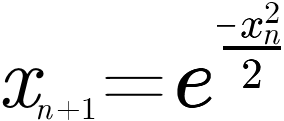 The deep-gauss constant is the only solution to the equation
The deep-gauss constant is the only solution to the equation
 An efficient way to calculate the constant is using Newton's method
which converges quadratically.
An efficient way to calculate the constant is using Newton's method
which converges quadratically.
 The following is an equivalent method of Newton iteration but tends to converge more slowly.
The following is an equivalent method of Newton iteration but tends to converge more slowly.
 Graphically, the point (gd, gd) is at the intersection between the gaussian
curve, its inverse, and the line y = x. The point is also a global fixed attractor
as illustrated by the black dashed line on the graph below.
Graphically, the point (gd, gd) is at the intersection between the gaussian
curve, its inverse, and the line y = x. The point is also a global fixed attractor
as illustrated by the black dashed line on the graph below.

It is also equal to the square-root of the product-log of 1, or equivalently the square root of the omega constant.
In Mathematica, the deep-gauss constant can be computed by
N[Sqrt[ProductLog[1]], 1000]
We've been able to calculate the deep-gauss constant to 100 million digits. Here are the downloads for anyone who needs them:
Deep-gauss to 10 thousand digits
Deep-gauss to 100 thousand digits
Deep-gauss to 500 thousand digits
Deep-gauss to 1 million digits
Deep-gauss to 5 million digits
Deep-gauss to 20 million digits
Deep-gauss to 40 million digits
Deep-gauss to 50 million digits
Deep-gauss to 100 million digits
The first 100,000 digits of gd are